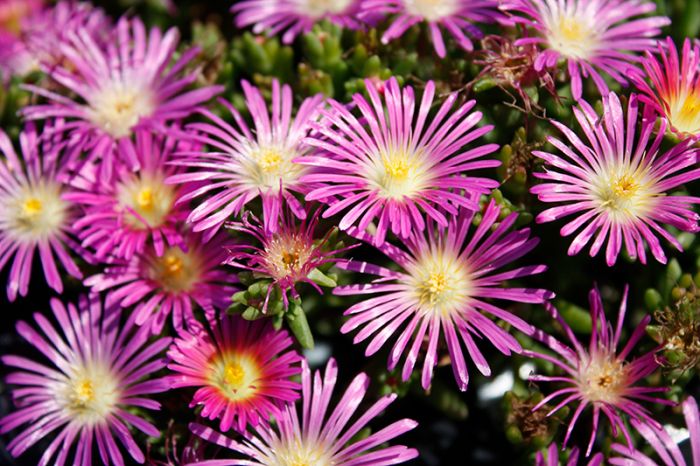Delosperma, Ice Plant 'Delmara™ Pink'


Out of stock
Sold out for the season- Sun Preference
- Full-Sun
- Bloom Time
- June, July, August
Description
These plants are long blooming and very cold hardy, drought tolerant, low maintenance, and deer resistant.
Delmara™ Pink Ice Plant features neon pink flowers with a yellow eye. Drought tolerant, succulent foliage is continuously covered in the electric blooms from late spring to fall.
Minnesota's Largest Selection of Perennials
Discover an unparalleled selection of perennials at Gertens! With the largest variety in Minnesota, we offer endless options of colorful perennials, natives, and pollinator plants to beautify your garden year after year. From vibrant flowers to lush foliage, our perennials are perfect for adding beauty and charm to your outdoor space. Visit Gertens today and see why we're known as Minnesota's Destination Garden Center!
Details
Delosperma cooperi ‘Delmara Pink’ | Delmara™ Pink Ice Plant
Plant Height: 4 inches
Flower Height: 6 inches
Spacing: 12 inches
Sunlight: ![]()
Hardiness Zone: 5a
Group/Class: Delmara™ Series
Brand: Green Fuse Botanicals
Description:
A low growing carpet-like, succulent, native to South Africa but amazingly hardy in North America; dazzling hot pink, daisy-like flowers with butter centers; perfect for xeriscapes, rock gardens, screes and sandy soils
Ornamental Features
Delmara™ Pink Ice Plant features showy hot pink daisy flowers with yellow eyes and buttery yellow centers rising above the foliage from late spring to late summer. Its attractive small succulent narrow leaves are bluish-green in color. As an added bonus, the foliage turns a gorgeous burgundy in the fall.
Landscape Attributes
Delmara™ Pink Ice Plant is an herbaceous evergreen perennial with a ground-hugging habit of growth. Its relatively fine texture sets it apart from other garden plants with less refined foliage.
This is a relatively low maintenance plant, and is best cleaned up in early spring before it resumes active growth for the season. It is a good choice for attracting bees and butterflies to your yard. It has no significant negative characteristics.
Delmara™ Pink Ice Plant is recommended for the following landscape applications;
- Mass Planting
- Rock/Alpine Gardens
- Border Edging
- General Garden Use
- Container Planting
Planting & Growing
Delmara™ Pink Ice Plant will grow to be only 4 inches tall at maturity extending to 6 inches tall with the flowers, with a spread of 15 inches. When grown in masses or used as a bedding plant, individual plants should be spaced approximately 12 inches apart. Its foliage tends to remain low and dense right to the ground. It grows at a fast rate, and under ideal conditions can be expected to live for approximately 5 years. As an evegreen perennial, this plant will typically keep its form and foliage year-round.
This plant should only be grown in full sunlight. It prefers dry to average moisture levels with very well-drained soil, and will often die in standing water. It is considered to be drought-tolerant, and thus makes an ideal choice for a low-water garden or xeriscape application. It is not particular as to soil pH, but grows best in sandy soils. It is somewhat tolerant of urban pollution. This particular variety is an interspecific hybrid. It can be propagated by cuttings; however, as a cultivated variety, be aware that it may be subject to certain restrictions or prohibitions on propagation.
Delmara™ Pink Ice Plant is a fine choice for the garden, but it is also a good selection for planting in outdoor pots and containers. Because of its spreading habit of growth, it is ideally suited for use as a 'spiller' in the 'spiller-thriller-filler' container combination; plant it near the edges where it can spill gracefully over the pot. Note that when growing plants in outdoor containers and baskets, they may require more frequent waterings than they would in the yard or garden. Be aware that in our climate, most plants cannot be expected to survive the winter if left in containers outdoors, and this plant is no exception. Contact our experts for more information on how to protect it over the winter months.
| SKU | Container Size |
| P1362 | #1 Container (1 Gallon) |
* Not all container sizes may be available at this time. See store for details on specific container size availability.
More Information
| Common Family Name | Ice Plant |
|---|---|
| Gerten Grown Plants | Gerten Grown Plants |
| Available for Pre-Order | No |
| Sun Preference | Full-Sun |
| Bloom Time | June, July, August |
| Mature Spread (Range) | 12" - 24" |
| Mature Height (Range) | 7-12" |
| USDA Hardiness Zone | 4, 5, 6, 7, 8, 9 |


